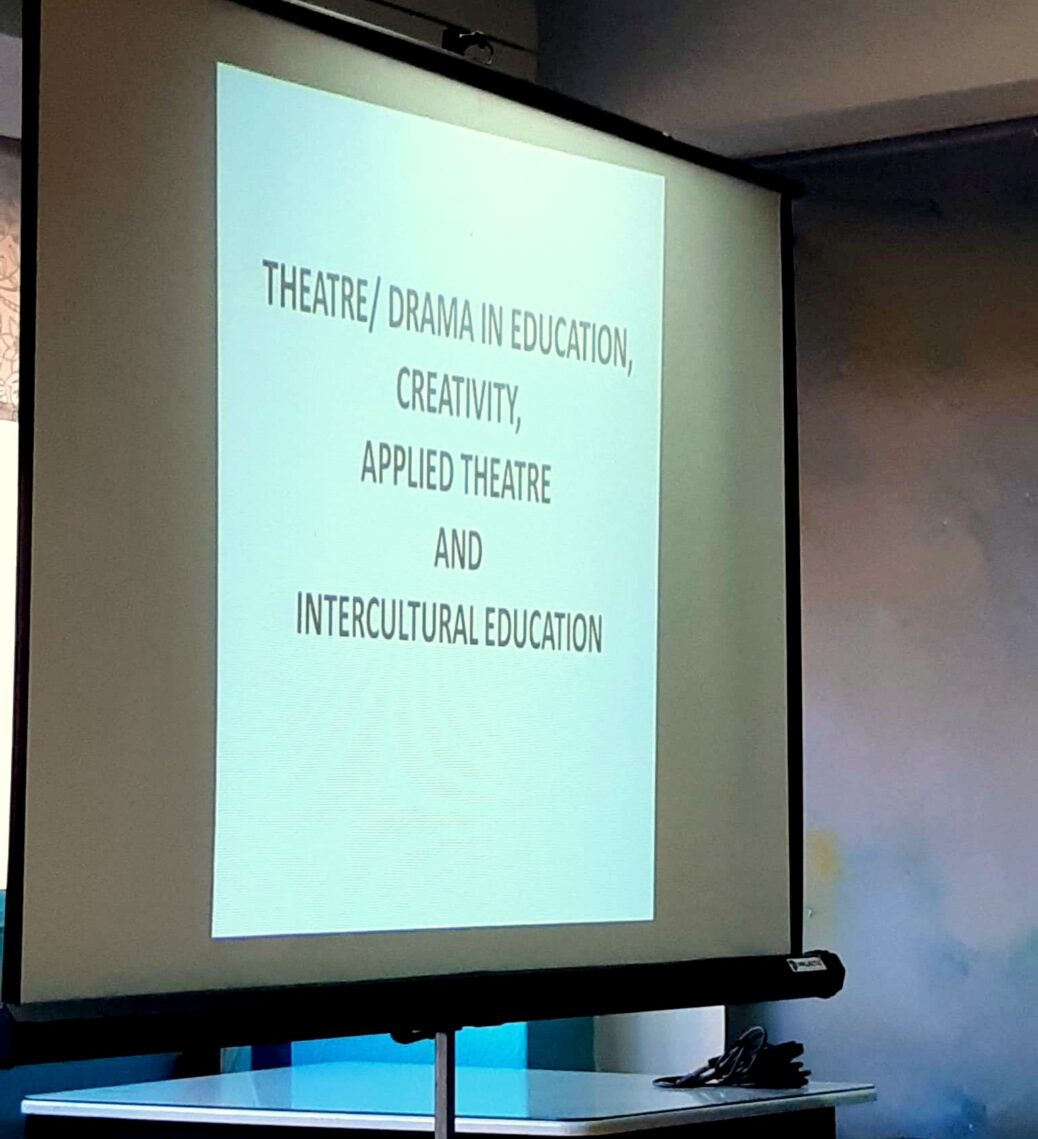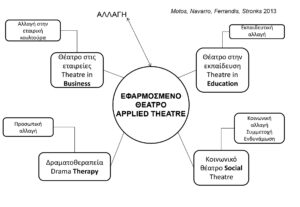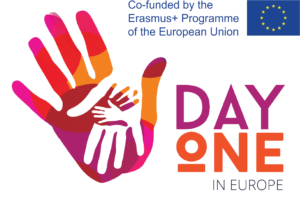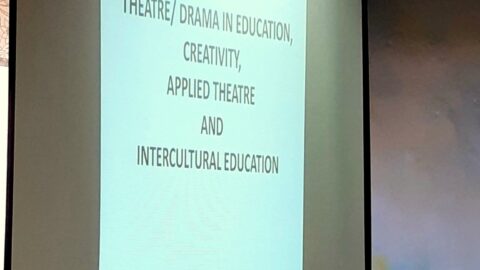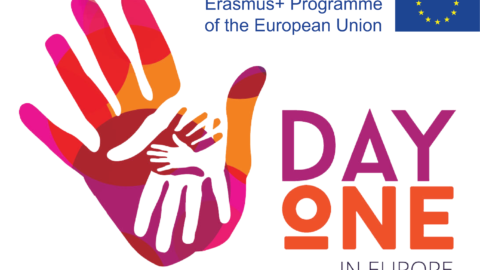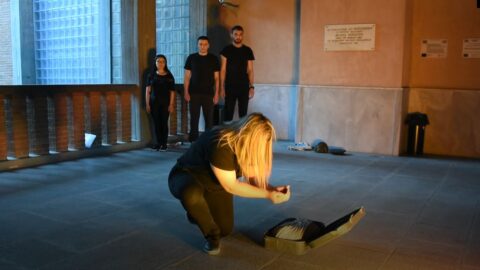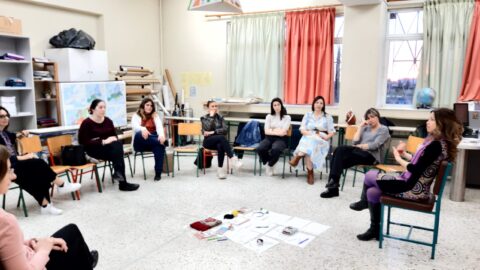ΕΦΑΡΜΟΣΜΈΝΟ ΘΈΑΤΡΟ/ΔΡΆΜΑ
Μάρθα Κατσαρίδου[1]*
Koldo Vío[2]**
DOWNLOAD FILE:
εφαρμοσμένο θέατρο – δραμα_GR
0B Applied Theatre_EN
Ο όρος Εφαρμοσμένο Θέατρο/Δράμα εισάγεται το 1990 ενώ ουσιαστικά επικρατεί την επόμενη δεκαετία. Σύμφωνα με την Helen Nicholson ο όρος χρησιμοποιείται για να περιγράψει κάθε είδους θεατρική δραστηριότητα που επιτελείται εκτός των παραδοσιακών θεατρικών οικοδοµηµάτων και που στοχεύει στην ωφέλεια των ατόµων, των κοινοτήτων και των κοινωνιών (Nicholson 2014, 3). Αποτελεί ένα πεδίο σε εξέλιξη και εύλογα έναν όρο ομπρέλα, καθώς ανάλογα με το πλαίσιο και τη στόχευση εφαρμόζονται ποικίλες και διαφορετικές πρακτικές (Ackroyd 2000).
Ο Balme διατυπώνοντας το εύλογο ερώτημα που προκύπτει από την επιλογή του όρου Εφαρμοσμένο Θέατρο: «Εφαρμοσμένο σε τι;» απαντάει «σε εκείνους που συμμετέχουν στη θεατρική διαδικασία» (Balme 2012, 220). Στο Εφαρμοσμένο Θέατρο η έμφαση δεν δίνεται πλέον στο κοινό, που παρακολουθεί ή που ούτως ή άλλως εμπλέκεται στη θεατρική διαδικασία, αλλά στον/στη συμμετέχοντα/ουσα που ενεργεί δραστικά και ολοκληρώνει τη θεατρική πράξη. Στο Εφαρμοσμένο Θέατρο η αισθητική είναι σημαντική όπως στο «θέατρο τέχνης». Ακόμη, παράσταση Εφαρμοσμένου θεάτρου μπορεί να παρουσιαστεί σε κοινό που δεν συμμετέχει στη θεατρική διαδικασία, αλλά επειδή υπάρχει κάποια σύνδεση με αυτό, απευθύνεται στους συγκεκριμένους θεατές και προσεγγίζει τους στόχους της.
Κάποιοι ειδικοί του χώρου διαχωρίζουν το Eφαρμοσμένο Θέατρο από το Εφαρμοσμένο Δράμα, υποστηρίζοντας ότι το πρώτο έχει ως βασικό χαρακτηριστικό τη θεατρική παράσταση και την ύπαρξη κοινού, ενώ το δεύτερο δίνει έμφαση στην ίδια τη διαδικασία, χωρίς να απαιτεί από τους/τις συμμετέχοντες/ουσες θεατρικές δεξιότητες και χωρίς απαραιτήτως να οδηγεί σε θεατρική παράσταση (Prendergast & Saxton 2013, xi-xii).
Συγκεκριμένα η Μonica Prendergast και η Juliana Saxton διαχωρίζουν από το Εφαρμοσμένο Θέατρο πρακτικές όπως η δραματοθεραπεία, οι θεατρικές πρακτικές σε εταιρίες, θεωρώντας ότι αυτές αφορούν περισσότερο στο πεδίο του Εφαρμοσμένου Δράματος, το οποίο βασίζεται στη διαδικασία, στη χρήση, δηλαδή θεατρικών πρακτικών εντός μιας ομάδας και όχι στη δημιουργία μιας θεατρικής παράστασης που απευθύνεται σε ένα κοινό.
Για τις δύο συγγραφείς, το Εφαρμοσμένο Θέατρο, ενώ αρχικά ακολουθεί παρόμοιες πρακτικές με αυτές του Εφαρμοσμένου Δράματος, καταλήγει τελικά σε δομημένη ή ημι-δομημένη παράσταση, όπου εμπλέκεται ένα κοινό. Η δημιουργία παράστασης, δηλαδή, αποτελεί ιδιαίτερο χαρακτηριστικό του Εφαρμοσμένου Θεάτρου (Prendergast & Saxton 2009, vi).
Το Εφαρμοσμένο Θέατρο στοχεύει εμφανώς είτε να επιβεβαιώσει είτε να θέσει υπό αμφισβήτηση κοινωνικό-πολιτικoύς κανόνες, προκειμένου να ασκήσει κριτική, να αναδείξει τον τρόπο που λειτουργεί ο κόσμος και να οδηγήσει σε κοινωνική δράση και αλλαγή.
Οι Prendergast και Saxton αναφέρονται στις ακόλουθες μορφές Εφαρμοσμένου Θεάτρου:
Το Θέατρο της Κοινότητας, το Θέατρο της Ανάμνησης, το Θέατρο στο Μουσείο, το Θέατρο του Καταπιεσμένου, το Λαϊκό Θέατρο, το Θέατρο στην Εκπαίδευση, το Θέατρο στην Εκπαίδευση της Υγείας, το Θέατρο για την Ανάπτυξη, το Θέατρο της Τεκμηρίωσης (Θέατρο Ντοκουμέντο), το Θέατρο στις Φυλακές.
Για παράδειγμα το Θέατρο της Ανάμνησης, το Θέατρο της Κοινότητας και το Θέατρο στο Μουσείο θέτουν συνήθως ως στόχο τους να επαναβεβαιώσουν και να τιμήσουν τη μνήμη και την ιστορία. Από την άλλη πλευρά, το Θέατρο του Καταπιεσμένου, το Λαϊκό Θέατρο, το Θέατρο στην Εκπαίδευση, το Θέατρο στην Εκπαίδευση της Υγείας και το Θέατρο για την Ανάπτυξη εστιάζουν περισσότερο στην επανεξέταση του status quo, ώστε να προωθήσουν τη θετική κοινωνική αλλαγή. Το Θέατρο στις Φυλακές ποικίλει ανάλογα τους διαφορετικούς στόχους και το περιεχόμενο. H επιβεβαίωση ή η υπονόμευση των προθέσεων αποτελούν τους δύο τρόπους για να επανεξετάσουμε τον κόσμο, να ανακαλύψουμε πώς λειτουργεί, να συνειδητοποιήσουμε κριτικά τη θέση μας σε αυτόν και να αναζητήσουμε την κοινωνική αλλαγή (Prendergast & Saxton 2009, 8).
Αξίζει, βέβαια, να σημειωθεί ότι κάποιοι ειδικοί του πεδίου, παρά τις όποιες διαφορές υπάρχουν, δυσκολεύονται να διαχωρίσουν τους όρους Εφαρμοσμένο Θέατρο και Εφαρμοσμένο Δράμα και τους χρησιμοποιούν εναλλακτικά με μια προτίμηση στη χρήση του πρώτου όρου. Θεωρούν ότι δεν υπάρχει μια καθαρή διαφοροποίηση ανάμεσα στη δουλειά που εστιάζει περισσότερο στη διαδικασία ή στη θεατρική παράσταση (process-based work ή performance-based work), αλλά αναγνωρίζουν μια ιδιαίτερα δημιουργική σύνδεση ανάμεσα στη διαδικασία και το αποτέλεσμα (Nicholson 2014, 5). Υπέρμαχος της «ενοποιημένης προσέγγισης», όπως την αποκαλεί, είναι ο Jonothan Neelands, o οποίος, σε εκπαιδευτικά κυρίως περιβάλλοντα, προτείνει τη σύζευξη μεταξύ διαδικασίας και θεατρικού προϊόντος (drama και theatre) περιεχομένου και μορφής/φόρμας, εμπειρίας και δομής. Για τον Neelands το περιεχόμενο δεν μπορεί να διαχωριστεί από τη θεατρική φόρμα. Σύμφωνα με τον ίδιο, στόχος της ενοποιημένης προσέγγισης είναι η νοηματοδότηση της ανθρώπινης εμπειρίας και η ανάπτυξη κριτικής σκέψης μέσα από τη χρήση της θεατρικής φόρμας (Neelands 2000).
Σε αυτό το πλαίσιο, συνδέοντας δημιουργικά τη διαδικασία με το αισθητικό αποτέλεσμα ως δύο σημεία του ίδιου συνεχούς, οι Motos, Navarro, Ferrandis και Stronks (2013) προχωρούν στην παρακάτω κατηγοριοποίηση των μορφών Εφαρμοσμένου Θεάτρου/Δράματος, μια «ανοιχτή» και ευέλικτη κατηγοριοποίηση, που επιτρέπει την ένταξη κάθε μορφής του:
-
Θέατρο στην εκπαίδευση: μορφές Εφαρμοσμένου Θεάτρου στην τυπική και τη μη τυπική εκπαίδευση. Το θέατρο στην εκπαίδευση αποτελεί μία αισθητική εμπειρία που κινητοποιεί τους/τις εμπλεκόμενους/ες στην εκπαιδευτική διαδικασία να αναπτύξουν νέες διδακτικές προσεγγίσεις βασισμένες στο θέατρο (Motos, Navarro, Ferrandis & Stronks 2013, 145). Επιπλέον, αξίζει να σημειωθεί ότι η προσέγγιση του «θεάτρου στην εκπαίδευση» δύναται να γίνει με τρεις μορφές: 1) Ως μορφή τέχνης με το ανέβασμα θεατρικών παραστάσεων 2) ως διδακτικό μέσο για τη διδασκαλία διαφόρων μαθημάτων του αναλυτικού προγράμματος, 3) ως εργαλείο έρευνας και κοινωνικής παρέμβασης για τη λήψη αποφάσεων, την επίλυση προβλημάτων και την ανάπτυξη της προσωπική έκφρασης του/της μαθητή/τριας (Kατσαρίδου 2014, 177).
-
Κοινωνικό θέατρο: μορφές Εφαρμοσμένου Θεάτρου στη μη τυπική και άτυπη εκπαίδευση. Το Κοινωνικό Θέατρο στοχεύει στην κοινωνική δράση/παρέμβαση, τη συμμετοχή, την ενδυνάμωση και τελικά τον κοινωνικό μετασχηματισμό. «Η τέχνη δεν είναι μόνο αναπόληση, αλλά και δράση, και όπως κάθε δράση δύναται να αλλάξει τον κόσμο, έστω και λίγο» (Tony Kushner στο Nicholson 2014, 10). Σύμφωνα με τους Thompson & Schechner (2004, 12), το Κοινωνικό Θέατρο μπορεί να λαμβάνει χώρα σε ποικίλα μέρη με διαφορετικούς/ές συμμετέχοντες/ουσες. Παραδείγματα χώρων αποτελούν οι φυλακές, οι χώροι υποδοχής προσφύγων, τα νοσοκομεία, τα σχολεία, τα ορφανοτροφεία, οι οίκοι ευγηρίας. Αντίστοιχα, οι συµµετέχοντες/ουσες σε δράσεις Κοινωνικού Θεάτρου μπορεί να είναι ντόπιοι κάτοικοι, άτομα με ειδικές ανάγκες, πρόσφυγες, φυλακισμένοι/ες και ευρύτερα άτομα που ανήκουν σε ευάλωτες, μη προνομιούχες και περιθωριοποιημένες ομάδες. Επίσης, μπορεί να είναι μεμονωμένα άτομα που έχουν χάσει την αίσθηση του «ανήκειν» σε μια ομάδα, είναι εσωτερικά και εξωτερικά παραγκωνισμένα.
-
Δραματοθεραπεία (ή θεραπευτικό θέατρο) είναι «η εφαρμογή της θεατρικής τέχνης σε κλινικό, θεραπευτικό και κοινοτικό πλαίσιο, και αφορά άτομα τα οποία αντιμετωπίζουν προβλήματα ή διαταραχές» (Jennings 2005, 17). Είναι η περιοχή της προσωπικής αλλαγής ή/και της αλλαγής των μελών μιας ομάδας, η οποία νοείται ως θεραπεία, όπου το θέατρο και οι δραματικές τεχνικές χρησιμοποιούνται ως κοινωνικο-συναισθηματικό εργαλείο μάθησης (Motos, Navarro, Ferrandis & Stronks 2013, 131).
-
Θέατρο στις εταιρείες: Υπάρχουν διάφοροι τρόποι χρήσης του θεάτρου μέσα στις επιχειρήσεις: στην επιμόρφωση, σε εταιρικές εκδηλώσεις και στη συμβουλευτική των εργαζομένων. Μέσα από τις παραπάνω προτάσεις οι εργαζόμενοι/ες έχουν τη δυνατότητα να παρακολουθήσουν θεατρικές παραστάσεις ως απλό κοινό ή ακόμη να πάρουν μέρος σε συμμετοχικές παραστάσεις. Επιπλέον, θεατρικές τεχνικές δύνανται να αξιοποιηθούν με σκοπό την ανάπτυξη ορισμένων δεξιοτήτων των εργαζομένων ή/και να διευκολύνουν την εφαρμογή των αποκτημένων γνώσεων στην πράξη (Motos, Navarro, Ferrandis & Stronks 2013, 219).
Ουσιαστικά, οι Motos, Navarro, Ferrandis και Stronks (2013) «σχεδιάζουν» τον ακόλουθο χάρτη.
Βιβλιογραφια
Ackroyd, Judith, «Applied Theatre: Problems and Possibilities», Applied Theatre Researcher/IDEA Journal 1, 2000.
Balme, Christopher, (2013) Εισαγωγή στις Θεατρικές Σπουδές, Αθήνα, Πλέθρον.
Jennings, Sue (2005). Εισαγωγή στη δραματοθεραπεία. Θεραπευτικό θέατρο ο μίτος της Αριάδνης. Μτφρ. Φ. Μεγαλούδη, Αθήνα: Σαββάλας.
Κατσαρίδου, Μάρθα, (2014) Η Θεατροπαιδαγωγική μέθοδος, Μια πρόταση για τη διδασκαλία της λογοτεχνίας σε διαπολιτισμική τάξη, Θεσσαλονίκη: Σταμούλης Αντ.
Motos, Tomas, Navarro, Antoni, Ferrandis, Domingo, και Stronks, Dianne, (2013) Otros escenarios para el teatro: teatro para el cambio, personal, social en la educación, en la empres., Cidad Real: Ñaque Editora.
Neelands, Jonothan, και Goode, Tony (2000) Structuring Drama Work, Cambridge: Cambridge University Press.
Nicholson, Helen, (2014) Applied drama, The gift of theatre, Hampshire & N. York: Palgrave Macmillan.
Prendergast, Monica, και Saxton, Juliana (επιμ.), (2009) Applied Theatre Bristol & Chicago: Intellect.
Prendergast, Monica, και Saxton, Juliana (επιμ.), (2013) Applied Drama Bristol & Chicago: Intellect.
Thompson, James, και Schechner, Richard, «Why “Social Theatre”?», TDR, Τόµος 48, Τεύχος 3, 2004.
[1]* Επίκουρη καθηγήτρια, Παιδαγωγικό Τμήμα Προσχολικής Εκπαίδευσης, Πανεπιστήμιο Θεσσαλίας
[2] ** Θεατροπαιδαγωγός, Σκηνοθέτης
APPLIED THEATRE/DRAMA
Martha Katsaridou [1]*
Koldo Vío[2]**
The term Applied Theatre/Drama was introduced in 1990 and essentially became prevalent in the following decade. According to Helen Nicholson, the term is used as a kind of shorthand to describe forms of dramatic activity that primarily exist outside conventional mainstream theatre institutions, and which are specifically intended to benefit individuals, communities and societies (Nicholson 2014, 3). It is an evolving field and reasonably an umbrella term, as a variety of different practices are applied depending on the context and purpose (Ackroyd 2000).
Balme articulates the legitimate question that arises from the choice of the term Applied Theatre: “Applied to what?” he answers “to those who participate in the theatrical process” (Balme 2012, 220). In Applied Theatre the emphasis is no longer on the audience, who is watching or who is anyway involved in the theatrical process, but on the participant who is actively acting and completing the theatrical act. In Applied Theatre, aesthetics are as important as in “art theatre”. Furthermore, an Applied Theatre performance can be presented to an audience that does not participate in the theatrical process, but because there is some connection to it, it appeals to those audiences and reaches its goals.
Some experts in the field distinguish Applied Theatre from Applied Drama, arguing that the first has the theatrical performance and the existence of an audience as its main characteristic, while the latter emphasizes the process itself, without requiring theatrical skills from the participant(s) and without necessarily leading to a theatrical performance (Prendergast & Saxton 2013, xi-xii).
In particular, Monica Prendergast and Juliana Saxton distinguish practices such as drama therapy and theatre practices in companies, considering them to be more relevant to the field of Applied Drama, which is based on process, i.e. the use, within a group, of theatrical practices rather than the creation of a theatrical performance aimed at an audience.
For the two authors, Applied Theatre, while initially following similar practices to those of Applied Drama, ultimately results in a structured or semi-structured performance involving an audience. Performance creation, in other words, is a distinctive feature of Applied Theatre (Prendergast & Saxton 2009, vi). Applied Theatre clearly aims to either confirm or question socio-political norms in order to critique, highlight the way the world works and lead to social action and change.
Prendergast and Saxton (2009, 3-6) refer to the following forms of Applied Theatre:
Community-based Theatre, Reminiscence Theatre, Museum Theatre, Theatre of the Oppressed, Popular Theatre, Theatre in Education, Theatre in Health Education, Theatre for Development and Prison Theatre.
For example, Reminiscence Theatre, Community-based Theatre and Museum Theatre usually set out to reaffirm and honor memory and history. On the other hand, Theatre of the Oppressed, Popular Theatre, Theatre in Education, Theatre for Health Education and Theatre for Development focus more on re-examining the status quo in order to promote positive social change. Prison Theatre varies according to the different objectives and content. Reassertions or undermining intentions are the two ways of re-examining the world, discovering how it works, becoming critically aware of our place in it and seeking social change (Prendergast & Saxton 2009, 8).
It is, of course, worth noting that some experts in the field, despite any differences, find it difficult to distinguish between the terms Applied Theatre and Applied Drama and use them interchangeably with a preference for using the first term. There is a reluctance to make a neat separation between process and performance-based work, and many practitioners acknowledge that they have found a productive consonance between the two (Nicholson 2014, 5). In this context, Jonothan Neelands and Tony Goode, who see theatre as the ‘direct experience shared when people imagine and behave as if they were other than themselves in some other place and at another time”, propose the ‘convention approach’ in order to convey meanings. They argue that content can not be separated from form, experience from structure, drama from theatre. As they underline ‘The conventions selected are mainly concerned with the process of theatre as means of developing understanding about both human experience and theatre itself’ (Neelands & Goode, 2000, 1-8).
In this context, creatively linking process and aesthetic outcome as two points of the same continuum, Motos, Navarro, Ferrandis and Stronks (2013) proceed to the following categorization of Applied Theatre/Drama forms, an “open” and flexible categorization that allows for the inclusion of any form of Applied Theatre/Drama:
- Theatre in education: forms of Applied Theatre in formal and non-formal education. Theatre in education is an aesthetic experience that motivates those involved in the educational process to develop new teaching approaches based on theatre (Motos, Navarro, Ferrandis & Stronks 2013, 145). Moreover, it is worth noting that the approach of “theatre in education” can be approached in three forms: 1) as an art form by staging theatrical performances 2) as a teaching tool for approaching various subjects of the curriculum, 3) as a tool of research and social intervention for decision making, problem solving and the development of the student’s personal expression (Katsaridou 2014, 177).
- Social theatre: forms of Applied Theatre in non-formal and informal education. Social Theatre aims at social action/intervention, participation, empowerment and ultimately social transformation. “Art is not merely contemplation, it is also action, and all action changes the world, at least a little” (Tony Kushner in Nicholson 2014, 10). According to Thompson & Schechner (2004, 12), Social Theatre can take place in a variety of places with different participant(s). Examples of places include prisons, refugee reception areas, hospitals, schools, orphanages, and nursing homes. Similarly, participants in social theatre activities may be local residents, people with disabilities, refugees, prisoners and, more generally, people belonging to vulnerable, disadvantaged and marginalized groups. They may also be individuals who have lost their sense of belonging to a group, being internally and externally marginalized.
- Drama therapy (or therapeutic theatre) is “the application of theatre arts in clinical, therapeutic and community contexts, and involves individuals who are experiencing problems or disorders” (Jennings 2005, 17). It is the area of personal change and/or change in group members, understood as therapy, where theatre and dramatic techniques are used as a social-emotional learning tool (Motos, Navarro, Ferrandis & Stronks 2013, 131).
- Theatre in companies: There are various ways of using theatre within companies: in training, in corporate events and in employee counselling. Through the above suggestions, employees have the opportunity to attend theatre performances as a simple audience or even to take part in participatory performances. In addition, theatrical techniques can be used to develop certain skills of employees and/or facilitate the application of acquired knowledge in practice (Motos, Navarro, Ferrandis & Stronks 2013, 219).
Essentially, Motos, Navarro, Ferrandis and Stronks (2013) ‘draw’ the following map:
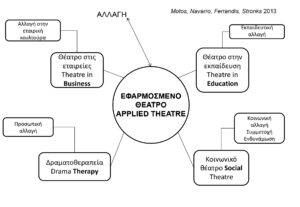
Bibliography
Ackroyd, Judith, “Applied Theatre: Problems and Possibilities”, Applied Theatre Researcher/IDEA Journal 1, 2000. (available at http://www.griffith.edu.au/_data/assets/pdf_file/0004/81796/Ackroyd.pdf)
Balme, Christopher, (2013) Εισαγωγή στις Θεατρικές Σπουδές [Introduction to Theatre Studies], Athens: Plethron.
Jennings, Sue, (2005) Εισαγωγή στη δραματοθεραπεία. Θεραπευτικό θέατρο ο μίτος της Αριάδνης [Introduction to drama therapy. Therapeutic drama the Ariadne’s mite]. Translation F. Megaloudi, Athens: Savvalas.
Katsaridou, Martha, (2014) Η Θεατροπαιδαγωγική μέθοδος, Μια πρόταση για τη διδασκαλία της λογοτεχνίας σε διαπολιτισμική τάξη [The Theatropedagogical Method, A proposal for the teaching of literature in an intercultural classroom], Thessaloniki: Stamoulis.
Motos, Tomas, Navarro, Antoni, Ferrandis, Domingo, and Stronks, Dianne, (2013) Otros escenarios para el teatro: teatro para el cambio, personal, social en la educación, en la empresa [Other scenarios for theatre: theatre for change, personal, social, in education, in business], Cidad Real: Ñaque Editora.
Neelands, Jonothan, and Goode, Tony (2000) Structuring Drama Work, Cambridge: Cambridge University Press.
Nicholson, Helen, (2014) Applied drama, The gift of theatre, Hampshire & N. York: Palgrave Macmillan.
Prendergast, Monica, and Saxton, Juliana (ed.), (2009) Applied Theatre Bristol & Chicago: Intellect.
Prendergast, Monica, and Saxton, Juliana (ed.), (2013) Applied Drama Bristol & Chicago: Intellect.
Thompson, James, and Schechner, Richard, «Why “Social Theatre”?», TDR, Vol. 48, Issue 3, 2004.
[1]* Assistant Professor, Department of Early Childhood Education, University of Thessaly, Greece
[2] ** Theatre educator, Director

